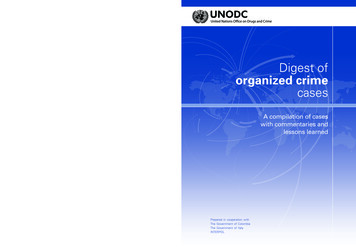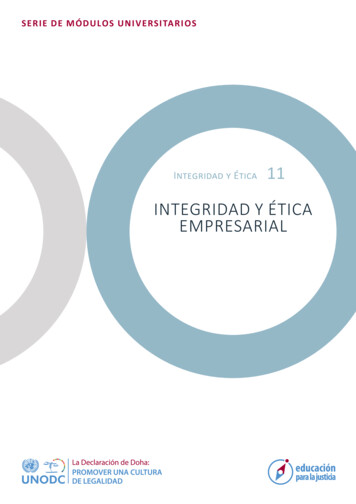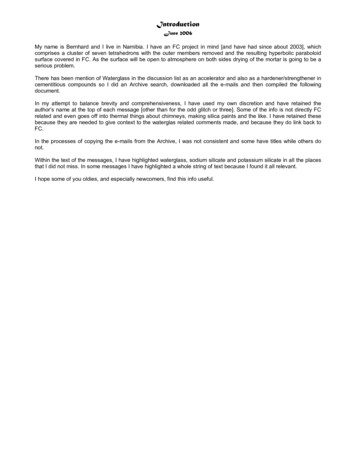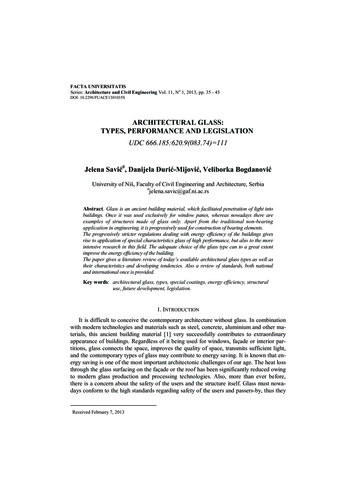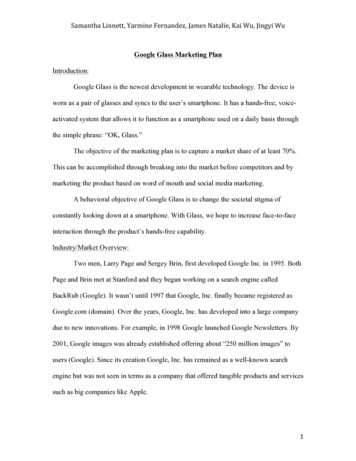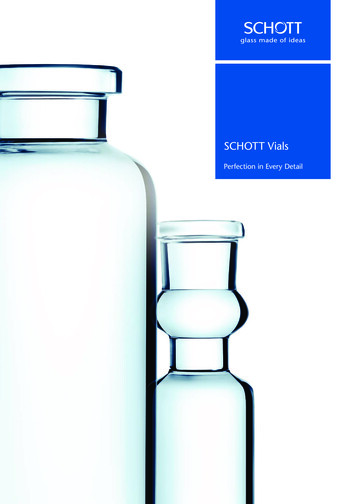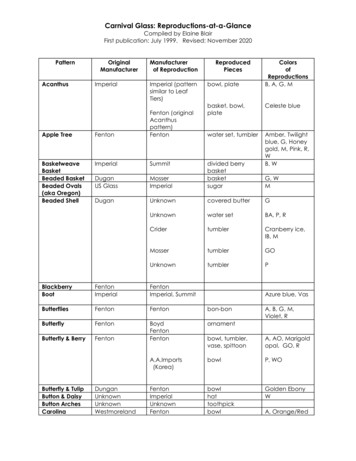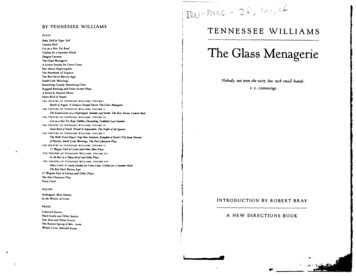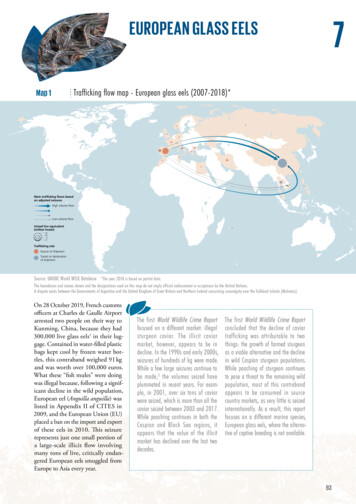
Transcription
7EUROPEAN GLASS EELSTrafficking flow map - European glass eels (2007-2018)*Map 1Main trafficking flows basedon adjusted seizuresHigh volume flowLow volume flowSeized live equivalent(million heads)15105 1Trafficking roleSource of shipmentTransit or destinationof shipmentSource: UNODC World WISE Database *The year 2018 is based on partial data.The boundaries and names shown and the designations used on this map do not imply official endorsement or acceptance by the United Nations.A dispute exists between the Governments of Argentina and the United Kingdom of Great Britain and Northern Ireland concerning sovereignty over the Falkland Islands (Malvinas).On 28 October 2019, French customsofficers at Charles de Gaulle Airportarrested two people on their way toKunming, China, because they had300,000 live glass eels1 in their luggage. Contained in water-filled plasticbags kept cool by frozen water bottles, this contraband weighed 91 kgand was worth over 100,000 euros.What these “fish mules” were doingwas illegal because, following a significant decline in the wild population,European eel (Anguilla anguilla) waslisted in Appendix II of CITES in2009, and the European Union (EU)placed a ban on the import and exportof these eels in 2010. This seizurerepresents just one small portion ofa large-scale illicit flow involvingmany tons of live, critically endangered European eels smuggled fromEurope to Asia every year.The first World Wildlife Crime Reportfocused on a different market: illegalsturgeon caviar. The illicit caviarmarket, however, appears to be indecline. In the 1990s and early 2000s,seizures of hundreds of kg were made.While a few large seizures continue tobe made, 2 the volumes seized haveplummeted in recent years. For example, in 2001, over six tons of caviarwere seized, which is more than all thecaviar seized between 2003 and 2017.While poaching continues in both theCaspian and Black Sea regions, itappears that the value of the illicitmarket has declined over the last twodecades.The first World Wildlife Crime Reportconcluded that the decline of caviartrafficking was attributable to twothings: the growth of farmed sturgeonas a viable alternative and the declinein wild Caspian sturgeon populations.While poaching of sturgeon continuesto pose a threat to the remaining wildpopulation, most of this contrabandappears to be consumed in sourcecountry markets, as very little is seizedinternationally. As a result, this reportfocuses on a different marine species,European glass eels, where the alternative of captive breeding is not available.93
EUROPEAN GLASS EELSFreshwater eels are one of the mostwidespread marine genera and arepart of the national cuisine in countries around the world. Europeaneels, like most sturgeons, are diadromous, which means they spend partof their life cycle in saltwater and partin freshwater. While sturgeons spendmost of their lives in saltwater andreturn to the freshwater to breed, eelsdo it the other way around, spending most of their lives in rivers andstreams and returning to sea to mate.Scientists believe that both Europeanand American eel (Anguilla rostrata)breed in the Sargasso Sea, a calm areaof the North Atlantic bordered byocean currents and home to a characteristic seaweed.3 While this breedinghas never been witnessed, capturedWeight equivalent of European eels seized and numberof European eel seizures (live, fingerlings), 2011-2018*Fig. 16,867.6Number of eel seizuresWeight of eels seized (in : UNODC World WISE Database* The year 2018 is based on partial data. It is therefore not directly comparable to data from other years.European eel produced (aquaculture and capturefisheries) in Europe, 1990-2017Fig. 220,00017,500metric tons12,50010,0007,5005,0002,500Source: 994199201990WORLD WILDLIFE CRIME REPORT 202015,000larvae grow increasingly larger radiating from the Sargasso Sea toward theUnited States and European coastlines.4After riding the Gulf Stream to theEuropean and North African estuariesover the course of a year or longer, thearriving larvae have matured to theglass eel stage, reaching between sixand eight centimetres in length. Thesejuveniles, referred to as “glass eels”due to their transparent appearance,are needed for aquaculture becauseadult European eels have never beensuccessfully bred in captivity. Thismeans that, unlike sturgeon caviar,demand for wild caught eels cannotbe replaced by captive breeding.And since populations of Japaneseeel (Anguilla japonica), American eeland European eel are in steep decline,some of the multi-billion-dollar5 eelindustry appears to have become reliant on poaching.The legal global eelmarketEel products are legally produced andconsumed in countries around theworld. This legal market is relevant toa discussion of eel trafficking, becauseit is largely fed by aquaculture producers who may receive some of theirglass eel stock from illegal sources.Unlike contraband like street drugs,there is no back-alley black marketfor eel meat products. Rather, similar to some other wildlife products,legitimate products can be taintedby illegitimate sources of supply. Thefollowing section describes the parameters and trends of this legal marketand the role European glass eels haveplayed in it.Adult eels may be caught from riversfor consumption, but most eels consumed today come from aquaculture.In 2017, FAO statistics showed thatover 96 per cent of the global eelsupply was from aquaculture.6 Asexplained later in this chapter, someof these farming operations make useof illegally taken glass eels.
- -- Anguilla japonica (Japanese eel),8- -- Anguilla rostrata (American eel),9- -- Anguilla bicolor (shortfin eel),10and- -- Anguilla anguilla (European eel).According to the IUCN, shortfineels are classified as “Near Threatened”, with an uncertain populationtrend.11 Both Japanese and Americaneels are “Endangered”, European eelsare ”Critically Endangered”, and allthree species have a declining population trend.12 However, only Europeaneel is CITES-listed (Appendix II asof 2009) and, in 2010, the European Union banned all European eelimports and exports. While sourcingand trading of other eel species couldbe contrary to national fisheries laws,only European eels are subject tointernational controls, and so theyare the focus of this chapter.For more than 50 years, stock abundance and fishing yield of Europeaneels have declined by about 5 per centannually, to less than 10 per cent oftheir historical levels today.14 In the1980s, official glass eel catch figuresfor Europe exceeded 3,000 tons peryear, but between 2010 and 2016, theofficial catch was less than 60 tons.15This decline is due to a number offactors, not just overexploitation,16but the species has been deemed toovulnerable for international commercial trade from the European Union.National trade data show that France,Spain, Portugal and the United Kingdom hosted the primary fisheries forglass eels in the past, and a differentgroup of countries (particularly theNetherlands, Denmark and Germany)grew the glass eels to maturity andprocessed the meat. Today, the Portuguese fishery is strongly restricted,so most of the legal glass eel catch inEurope comes from the other threecountries:- -- In Spain, the situation is compli-cated by the fact that the coastalareas have autonomous status,so the fishery is regulated locallywith no national quota, and recreational fishing of glass eels forpersonal consumption is allowedin some areas.17Only the import and export of European eel are banned in the EuropeanUnion.13 Production of eel in the EUfor European consumption continues, although at greatly reduced levelscompared to 30 years ago (Figure 2).Fig. 3Live eel imports in2018 by importingregion (US millions)- -- In France, a national quota is setCASE STUDY: European glass eelsThere are many species of freshwatereel (of the genus Anguilla), but itappears that just four provide mostof the glass eels for eel aquaculture:77(just under 65 tons for 20172018), which is the sum of localquotas and includes glass eels setaside for restocking.18- -- In the United Kingdom, there isno national quota, but fishing islimited to the use of hand netsby a small number of fishers(about 300) operating during aconstrained season in a limitedgeographic area.19The volumes legally fished for Europeappear to be less than those illegallyexported for aquaculture. Global seizures alone can represent more than10 per cent of the French nationalquota, and have trended upward since2011, the year after the eel export banwas put in place (Figure 1). Based onWorld WISE data, Spain, France andPortugal appear to be the source ofmost of glass eels seized today. Seizure data also show the destinationof these glass eels is also the regionwith the highest legal production:Asia. In 2017, 96 per cent of globalaquaculture eel production took placein Asia.20Traditionally, Asian eel productionwas based on Japanese eel, butdeclines in catches have forced theindustry to import glass eels of otherJuvenile eels (Anguilla japonica) legally caughtin Japan (tons), 1957-2017Fig. 4250Rest of the world35Europe43Metric tons20015010050Source: UN 67196201957Asia674Source: Japan Fisheries Agency95
EUROPEAN GLASS EELSspecies. Based on UN Comtradedata, 89 per cent of the world’s liveeel imports (including glass eels) weremade by Asian countries in 2018, particularly Japan, the Republic of Koreaand China (Figure 3). Japan was theleading importer, importing virtuallyall its live eels from China.species of the glass eels on which thisproduction is based has varied overtime. Until exports from the European Union were banned in 2010,most of the Chinese eel productionwas based on European eel (78 percent in 2008-9, see Figure 6). Sincethen, there have been limited CITEScertified exports of live European eelfrom North Africa, which is withinthe range of the European eel but outside the EU export restrictions.The 2010 EU export restriction triggered a rush for glass eels from othersources. Based on UN Comtradeimport data, it appears that demandfor Chinese aquaculture was satisfied by imports from Malaysia andthe Philippines (presumably shortfinMetric tonsNowhere are eels more important asa food source than in Japan, whereunagi kabayaki is popular year-round,Imports of glass eels into legal aquaculture ponds inbut traditionally eaten by everyone Fig. 6on the Midsummer Day of the Ox.China (tons), 2008-2016Fisheries catches of Japanese eels(Anguilla japonica) have been steadily80declining since the 1960s (Figure 4)70due to a variety of factors, includingover-exploitation.21 The species has60been classified as “Endangered” on50the IUCN Red List since 2014.22Parallel to this decline, export of40European eels to East Asia began to30rise steeply in the 1970s.23 According to the CITES Trade database, in202009,24 Japan imported 96 per cent of10the legally traded European eel meat.25While Japan dominates imports,0China dominates aquaculture produc2008-9 2009-10 2010-11 2011-12 2012-13 2013-14 2014-15 2015-16tion. In 2017, 85 per cent of globalJapaneseEuropeanAmericanShortfineel production by weight occurred inChina (Figure 5). The combination of Source: CITESImports of glass eelsinto legal aquacultureponds in China (tons),2008-2016Fig. 5Legal imports of live glass eels to China by exportingcountry (US millions), 2001-2018Fig. 725Japan8%Others0%US (millions)20Republic ofKorea4%Europe3%1510Source: 007200620052004200302002China85%2001WORLD WILDLIFE CRIME REPORT 20205France, Spain, and United KingdomPhilippines and MalaysiaUnited States and CanadaOthersSource: UN Comtrade
- -- commercial fishers who catchglass eels for the legal market andknowingly or unknowingly supplyillegal exporters (diversion);- -- poachers, who fish clandestinelywith the intent to supply theillegal market.For example, European investigationsuncovered a Spanish eel trader whowas working with a Greek eel farm toillegally export large (800 kg) shipments of glass eels to China. The eelswere illegally taken in Spain, transported in trucks to Barcelona, andthen by ferry to Italy and onwardsto Greece, where the legal eel farmwas located.29 This ostensibly legalfarming operation gave cover to bothillegal fishing and illegal export.CASE STUDY: European glass eelseel) initially, but increasingly from theUnited States and Canada (presumably American eel) (Figure 7). Theshift in demand outside Europe canbe seen, for example, in export dataon American glass eels. In the stateof Maine, the catch quadrupled asprices increased twenty-fold in threeyears, from just under US 100 perpound (454 g)26 in 2009 to just underUS 2,000 per pound in 2012. Theincrease in both price and volumecaused a sharp increase in the totalmarket size in 2012 (Figure 8). In2018, renewed demand for Americaneel was seen, albeit at lower prices, suggesting a competing source of supply.7Established eel traders have beenfound to be involved in illegal exports,so any commercial fisherman sellingglass eels to a trader could unwittinglybe complicit in illegal exports. Commercial traders can also be involved In parallel, there are also networksin acquiring glass eels illegally and of poachers who acquire their glassthen further exporting them illegally. eels clandestinely. Based on 9961994US millionsRecorded value of the legal American glass eel fisheryDespite population declines and fluc- Fig. 8tuations in the source of glass eels,(Anguilla rostrata) in the state of Maine (US millions),global eel production has remained1994-2018remarkably consistent over the45years, driven by rising production in40China (Figure 9). Although the 201035ban on exports from the EuropeanUnion did cause a slight decli
sturgeon caviar. The illicit caviar market, however, appears to be in decline. In the 1990s and early 2000s, seizures of hundreds of kg were made. While a few large seizures continue to be made,2 the volumes seized have plummeted in recent years. For exam-ple, in 2001, over six tons of caviar were seized, which is more than all the caviar seized between 2003 and 2017. While poaching continues .
